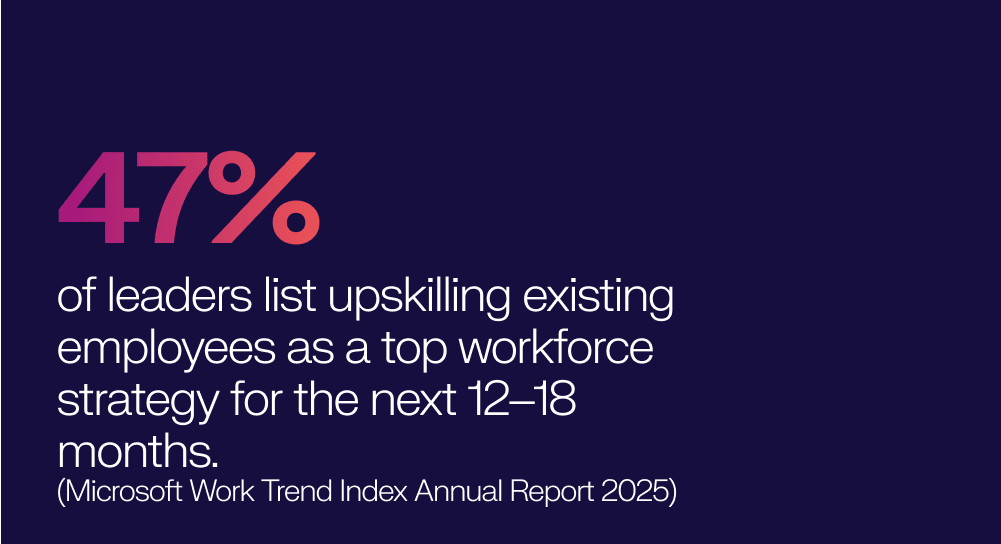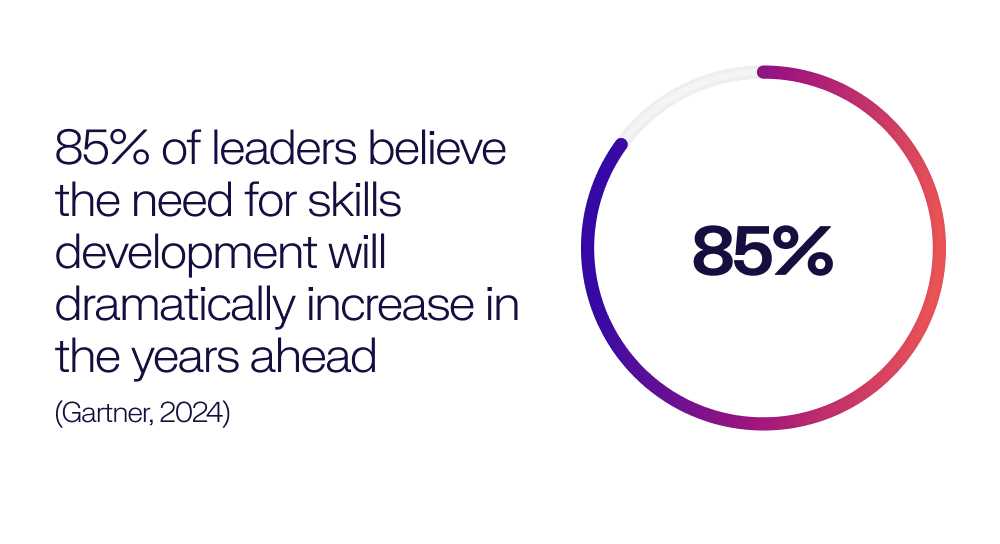7 Key Benefits Of Upskilling Your Employees For Business Success
In an era of constant change and digital disruption, upskilling has become one of the most powerful – and necessary – tools for long-term business success.
“Upskilling the existing workforce” is the most commonly cited workforce strategy under consideration among business leaders over the next 12–18 months — with 47% ranking it in their top three, according to Microsoft’s Work Trend Index Annual Report 2025.
As emerging technologies reshape industries and customer expectations evolve, organizations must adapt – not only through new strategies and systems, but by investing in the development of their people.
“The skills gap continues to be the most significant barrier to business transformation today, with nearly 40% of skills required on the job set to change.” – World Economic Forum Future of Jobs Report 2025
Businesses can’t embrace transformation without addressing the skills gap – and they can’t close that gap through hiring alone. Upskilling is no longer a nice-to-have; it’s a critical enabler of agility, innovation, and sustainable growth. It’s how organizations unlock workforce potential and prepare for the future with confidence.

What is upskilling and why does it matter? 🤔
Upskilling is the process of teaching employees new skills or deepening their existing capabilities to help them thrive in their current roles – or transition into more advanced ones. It’s about futureproofing your workforce by equipping people to adapt to new tools, technologies, and business models.
Unlike reskilling, which prepares someone for a different role, or cross-skilling, which broadens their skillset across functions, upskilling focuses on depth – making people more expert and impactful in their areas of work.
And this is becoming mission-critical. According to Gartner research, 85% of leaders believe the need for skills development will dramatically increase in the years ahead.

In today’s fast-moving, tech-driven environment – where entire toolsets can change in months – upskilling is what enables your workforce to stay competitive, engaged, and resilient.
“AI is reshaping business models, with half of employers globally planning to reorient their business to target new opportunities resulting from the technology. The most common workforce response to these changes is expected to be upskilling workers, with 77% of employers planning to do so.” – World Economic Forum, Future of Jobs Report 2025
Key business benefits of upskilling ❤️
Upskilling provides a clear benefit for employees – boosting job satisfaction and motivation. But isn’t just a benefit for individuals. It drives clear, measurable outcomes across performance, planning, and long-term competitiveness. Here’s how:
Build organizational agility
According to Accenture, 44% of working hours in the U.S. are now in scope for automation or augmentation. In this landscape, a workforce equipped with adaptable, future-ready skills can pivot quickly and absorb change without major disruption.
Upskilling makes it easier to move people across teams and functions, reducing dependency on external hiring and supporting internal mobility, career progression, and succession planning at scale.
Close strategic capability gaps
The rise of AI and automation is just one of the factors leading to growing skills gaps, globally – but any company looking to transform, innovate, grow or simply survive will be facing gaps in several areas.
More than 10% of professionals hired today have job titles that didn’t even exist in 2000 – roles like AI Engineer and Head of AI. By 2030, 70% of the skills used in most jobs will change. – LinkedIn Work Change Report
Leaders need new ways to close skills gaps through unlocking human potential. Upskilling is an excellent route to closing capability gaps, if you can spot the right areas for training (growing demand) and the people who could benefit most from the development.
Accelerate innovation and productivity
A culture of learning fosters curiosity, experimentation, and cross-functional collaboration. Employees who continuously grow are more likely to solve problems creatively, take initiative, and drive innovation from the ground up.
Upskilling also boosts engagement. When people feel their development is supported, they’re more confident, motivated, and aligned to company goals.
Improve retention of critical talent
One of the biggest reasons employees leave is a lack of development opportunities. When companies create clear paths for growth – including lateral moves and skill-based promotions – they build loyalty and reduce attrition.
67% of employees say they would stay at a company that offers advancement opportunities – even if they weren’t satisfied with the role itself. – Korn Ferry Talent Acquisition Trends 2025
Reduce hiring costs through internal development
Hiring externally for every emerging skill is expensive and slow. Developing talent from within reduces recruitment costs, accelerates time-to-productivity, and improves role fit.
“Hiring is cost intensive, since it takes time to onboard and ramp up an employee into a new role. While reskilling and upskilling also take time and resources, leaders can use these levers strategically, track their relative success, and shift gears as needed.” – McKinsey, 2025
Strengthen employer brand and attract talent
Top candidates increasingly expect companies to invest in their growth. A strong upskilling culture positions your organization as people-first and forward-thinking – boosting your reputation among both prospective hires and existing employees.
Promote diversity and inclusive growth
When learning and advancement opportunities are accessible to everyone – not just top performers or well-connected employees – upskilling helps level the playing field. It empowers underrepresented talent to thrive and contributes to a more equitable culture overall.
Core areas where upskilling delivers the greatest impact 📈
While every organization has unique needs, certain skill domains offer consistently high ROI when it comes to upskilling:
Digital & technical skills
With digital transformation accelerating, fluency in tools like AI, data analytics, and automation is no longer optional. Upskilling in these areas ensures your workforce can harness new technologies instead of being left behind by them.
51% of managers say AI training or upskilling will become a key responsibility for their teams within five years. (Microsoft)
Leadership & communication
As organizations flatten and teams become more cross-functional, strong leadership and interpersonal skills are essential. Upskilling in these areas supports collaboration, drives alignment, and helps future leaders emerge.
Problem-solving and innovation
Encouraging employees to think critically, challenge assumptions, and find creative solutions leads to innovation at every level. Upskilling fosters the mindset and skills needed to continually improve and adapt.
Adaptability and continuous learning
Perhaps the most valuable capability of all: the ability to learn. Building a growth mindset helps individuals – and organizations – continuously adapt to new challenges.
How to get started with upskilling at scale 💡
Before launching any program, it’s important to reframe how you assess talent. Many companies are already shifting toward hiring for potential – focusing less on existing qualifications, and more on foundational skills and growth mindset.
“Waiting to find an employee with all of the exact skills listed for a role significantly shrinks the pool of potential candidates … Instead, managers should focus on defining simple, foundational role requirements to reach a wider group of candidates.” – Annika Jessen, Director in the Gartner HR practice
Leadership buy-in is also essential. In fact, 93% of business leaders say it’s their responsibility to ensure their teams have time and support to develop continuously, according to Gartner research.
Still, it’s not always clear where to begin. Which skills matter most? Which employees need what kind of development? How do you ensure training is relevant and effective?
This is where AI-powered skills intelligence can transform the process. By analyzing workforce data, these tools reveal:
- The skills your organization already has
- The ones you’re likely to need next
- The biggest gaps and misalignments
This allows you to target upskilling more strategically and ensure it aligns with business objectives.
AI can also personalize learning journeys. Instead of offering generic training, it can recommend development opportunities that match each employee’s current role, career interests, and skill gaps – improving engagement, performance, and progression.
When integrated with your existing HR ecosystem, skills intelligence also makes it easier to track progress over time and adapt your strategy based on real outcomes.
“In a tech-powered future, people management will be much more proactive, data-driven, and fluid … adapting, reallocating, adjusting, and improving will become the norm.” – McKinsey
What’s next? ➡️
The upskilling landscape is evolving fast – shaped by rapid innovation, rising employee expectations, and growing demand for personalization at scale.
AI is transforming how companies design and deliver learning: enabling custom development paths tailored to each individual’s skills, aspirations, and role requirements. Microlearning, on-demand content, and dynamic recommendations are making it easier than ever to embed learning into the flow of work – especially for hybrid and global teams.
At the same time, upskilling is moving from the margins to the core of workforce planning. It’s no longer just an L&D priority – it’s a strategic lever for closing skills gaps, retaining talent, and building long-term business resilience.
To keep pace, organizations need more than standalone training programs. They need visibility into what skills they have, what they need, and how to connect people with the right opportunities to grow.
That’s where AI-powered skills intelligence comes in: enabling smarter decisions, faster action, and more targeted development at scale.